Cell biology/Membrane Assembly: Mechanism
Here is the link to the ITunes U Lecture from Berkeley. Membrane Assembly: Mechanism
Review
Blobel developed a way of taking ER membrane vesicles from pancreatic tissue. He then stripped the ribosomes off leaving the integral membrane proteins in tact. He then found that if he added ribosomes and translation material he could recreate the protein translation process.
How did he remove the ribosomes and the mRNA?
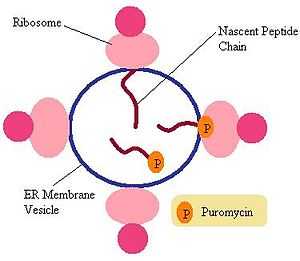
- It is harder than you might think to remove the ribosomes and mRNA. The ribosomes are attached electrostatically to the channel (so they are sensitive to ionic changes).
- The mRNA that is being translated acts like an anchor and it is hard to remove.
- Puromycin (antibiotic that is not that useful for human consumption) looks like the 3' end of the tRNA molecule. Puromycin tricks the ribosome into attaching it to the C-terminus of the nascent chain. Additionally, Puromycin does not hydrogen bond to the ribosome, which causes the release of the nascent chain.
- Now that the anchoring nascent chain is gone, the ribosome can be removed with a high salt buffer. This is how Blobel created virgin or smooth ER vesicles.
Blobel then added mRNA (for a secretory protein) and necessary translation factors (ATP, GTP, ect.) and fresh ribosomes. When all of this was mixed together, the mature protein was produced inside the vesicle.
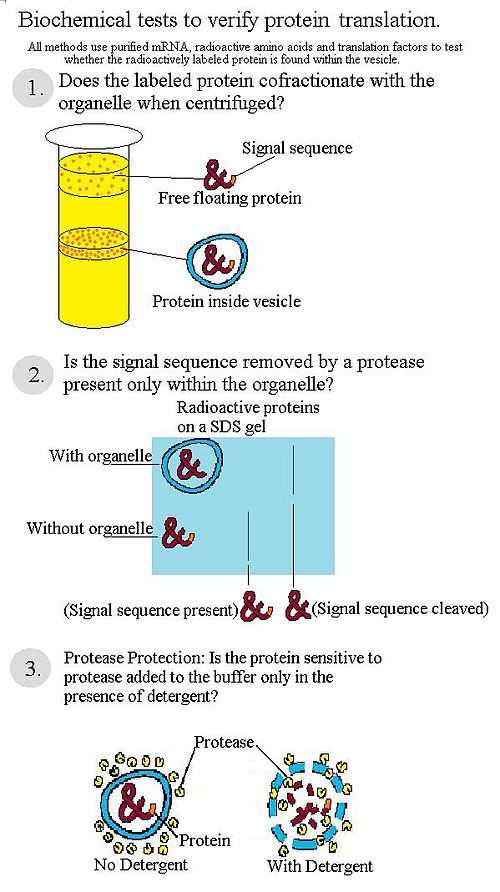
What is the sequence for the creation of a mature secretory protein?
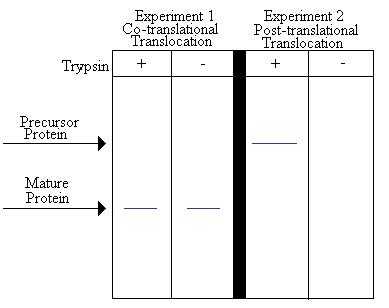
- You need the membrane to get the mature protein. In a solution with out the membrane, the precursor form is produced.
- His first experiment looked for a co-translational translocation, that is he looked to see if the mature protein could be produced within the vesicle if all of the materials were added at the beginning.
- His next experiment looked for post-translational translocation, that is he allowed the protein to be transcribed and then added the ER membrane vesicles. Both of these experiments were tested with an SDS page. (see graph of results)
- Looking at the results, you can see that experiment 1 produced mature proteins that were protected from protease because they were inside the vesicle. In experiment 2, you can see that no mature proteins were produced and the precursor protein was found only on the outside of the vesicle because it was not protease protected.
So we have learned that post-translational translocation does not occur, Why is that?
- The secretory proteins have 6 or more hydrophobic amino acids at the N-terminal domain (the part that would be synthesized first). *This hydrophobic core constitutes the information necessary to guide the nascent chain (from the cytoplasm) to the ER membrane so it can be translocated into the lumen of the ER while the protein is still being created.
What happens if the protein doesn't get to the ribosome early in the translation?
The hydrophobic core will hide itself in the protein or attach to other hydrophobic places in the cell and not be available to initiate translocation. So translocation occurs in the beginning or not at all.
Signal Hypothesis

States that there is special information (hydrophobic core) at the N-terminus of the secretory proteins to guide the nascent protein ribosome complex to a site on the ER membrane that allows it to be translocated to the ER lumen (and ultimately allows secretion from the cell).
What molecules are responsible for this reaction?
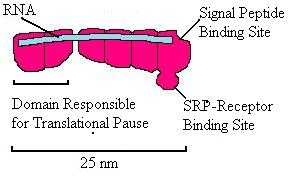
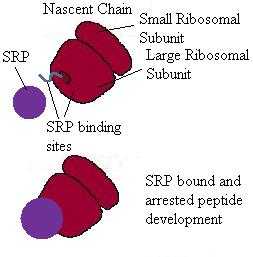
- Salt wash strips away anything peripherally bound to the ER membrane, and the previous experiment has used a crude mix of translation factors. If you utilized all pure translation factors, only the precursor molecule will be produced outside the vesicle.
- So what was present in the crude mix that is not found in the purified mix?
- If you just perform a salt wash of an ER membrane, to remove peripheral proteins but not ribosomes, and gather the supernatant you can add it to the purified factors and create mature proteins inside the vesicle. So obviously a peripheral protein is necessary for the translocation process.
- The important protein is called signal recognition particle (SRP) This complex recognizes the hydrophobic core and locks onto the nascent chain guiding it to the ER membrane. The signal recognition particle is the major ribonucleoprotein particle found within the cytoplasm. It is largely found on the cytoplasmic surface of the ER.
- SRP binds to the hydrophobic N-terminal of the nascent protein and then hydrogen bonds with the large subunit of the ribosome. This arrests translation.
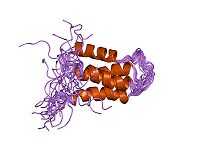 54KD SRP subunit
54KD SRP subunit
Why arrest peptide development?
- Arresting nascent chain development allows the process of translation and translocation to be synchronized.
- SRP's function: bind the nascent peptide and guide the nascent protein to the correct location.
- The 54KD subunit is the most well known has a GTP binding/hydrolysis site that opens a spot for the hydrophobic core and that location binds tightly and arrests development.
Are there other proteins necessary for this process?
- We have identified soluble proteins involved in the process but now we need to find the integral proteins necessary for this process. There are two. How were they identified?
- Again the Blobel lab used a technique called affinity chromatography.
- Make an affinity column packed with beads (solid support) to which a ligand is covalently attached (SRP). A buffer with ER membranes (that had been salt washed-no peripheral proteins left) and a detergent, that releases proteins from ER membrane, is ran through the affinity column. Proteins that are not attracted to SRP will flow through the affinity column but some proteins will be bound and can only be removed with harsh methods. So at the end you add harsh conditions such as pH changes or very ionic solutions which will break through protein protein attachments. This releases the necessary proteins that have bound to SRP.
- From this technique it was learned that SRP binds to an SRP receptor, which has two subunits that are integral membrane proteins. Both subunits are GTP binding proteins. When the nascent chain-SRP-ribosome complex attaches to the SRP receptor, it causes all the GTP to be hydrolyzed, which in turn, pushes the nascent chain out of the opening in SRP. The nascent chain is poised at the surface of the membrane and can now travel inside the ER lumen and once the nascent chain is freed protein synthesis can begin again.
Sadly, The SRP receptor is necessary but not sufficient for translocation.
Schekman's lab figured out that there is also a channel necessary. He used genetic research. Yeast needs to secrete in order to grow. His lab found a temperature sensitive lethal secretion mutant at sec61. The normal gene is SEC61. This will be explained in the next lesson. Look at [Bookshelf, Alberts Et. Al Textbook] for a description of experimental techniques including Schekman's laboratory technique with yeast cells.
Please feel free to add details or make changes where necessary. Contact me via email if you need help. Thanks, April